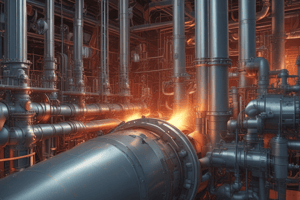Podcast
Questions and Answers
What is the primary purpose of a burner management system (BMS) according to the NFPA 85 Boiler and Combustion Systems Hazard Code?
What is the primary purpose of a burner management system (BMS) according to the NFPA 85 Boiler and Combustion Systems Hazard Code?
- Ensure safe burner operation by preventing misoperation and damage to fuel preparation and burning equipment. (correct)
- Enhance the aesthetics of the combustion equipment.
- Customize safety parameters for each individual burner.
- Maximize fuel efficiency in the combustion process.
Which components typically communicate with the Burner Management System (BMS) to ensure safe burner operation?
Which components typically communicate with the Burner Management System (BMS) to ensure safe burner operation?
- Fuel preparation and burning equipment.
- Boiler water level sensors.
- Igniters, combustion air switches, and pilot SSOVs. (correct)
- Boiler auxiliary systems.
According to Factory Mutual (FM), what customization options are available for operators and burner technicians in a typical burner management system (BMS)?
According to Factory Mutual (FM), what customization options are available for operators and burner technicians in a typical burner management system (BMS)?
- Full control over all combustion equipment operations.
- Limited selection of safety parameters like purge, trial for ignition, and flame failure response time. (correct)
- No customization options available.
- Unlimited customization of all safety parameters.
What is a key function of a burner management system (BMS) in relation to combustion equipment operation?
What is a key function of a burner management system (BMS) in relation to combustion equipment operation?
What type of programming configuration do most burner management systems (BMS) offer?
What type of programming configuration do most burner management systems (BMS) offer?
What does the NFPA 85 Boiler and Combustion Systems Hazard Code primarily aim to prevent through burner management systems (BMS)?
What does the NFPA 85 Boiler and Combustion Systems Hazard Code primarily aim to prevent through burner management systems (BMS)?
What is a key feature of programming controllers that distinguishes them from primary controls?
What is a key feature of programming controllers that distinguishes them from primary controls?
What is the purpose of pre-ignition interlock circuitry in programming controllers?
What is the purpose of pre-ignition interlock circuitry in programming controllers?
Why were modern programming controllers developed to be electronic devices instead of electro-mechanical drum sequencers?
Why were modern programming controllers developed to be electronic devices instead of electro-mechanical drum sequencers?
What is the main purpose of purge proving circuitry in programming controllers?
What is the main purpose of purge proving circuitry in programming controllers?
Why does the programming control need to recognize when airflow is low for the pilot burner?
Why does the programming control need to recognize when airflow is low for the pilot burner?
Which feature distinguishes programming controls from primary controls with respect to managing burner firing rates?
Which feature distinguishes programming controls from primary controls with respect to managing burner firing rates?
What is the main purpose of a burner management system (BMS)?
What is the main purpose of a burner management system (BMS)?
Which category of burner management systems is the most complex?
Which category of burner management systems is the most complex?
What is the purpose of 'Timed Ignition Period' in a primary control system?
What is the purpose of 'Timed Ignition Period' in a primary control system?
Why is it important for a primary control system to have 'Tined Flame Failure Response' function?
Why is it important for a primary control system to have 'Tined Flame Failure Response' function?
What does CSA B149.3 limit for the 'Pilot Trial-for-Ignition Period' in burners?
What does CSA B149.3 limit for the 'Pilot Trial-for-Ignition Period' in burners?
Which component is NOT part of a simple flame relay in a burner management system?
Which component is NOT part of a simple flame relay in a burner management system?
What can happen if the 'Timed Main Flame Trial-for-Ignition Period' exceeds recommended limits?
What can happen if the 'Timed Main Flame Trial-for-Ignition Period' exceeds recommended limits?
Flashcards are hidden until you start studying
Study Notes
Burner Management System (BMS) Overview
- The primary purpose of a BMS is to ensure the safe operation of burners and prevent hazardous situations during combustion processes.
- NFPA 85 outlines safety standards to minimize risks associated with boiler and combustion systems.
Communication with BMS
- Components that typically communicate with a BMS include:
- Flame detection devices
- Safety valves
- Combustion air control systems
- Fuel supply shutoff valves
Customization Options for BMS
- Factory Mutual (FM) allows operators and burner technicians to customize:
- Control logic and safety protocols
- User interfaces for monitoring and adjustments
- Alarm settings tailored to specific operational needs
Key Functions of BMS
- A BMS plays a crucial role in monitoring and controlling combustion equipment to maintain safe operating conditions.
- It ensures that hazardous conditions, such as gas leaks or flame outages, are promptly addressed.
Programming Configuration
- Most BMS systems utilize a flexible programming configuration which supports various combustion management strategies and safety interlocks.
NFPA 85 Prevention Goals
- The NFPA 85 standard aims to prevent incidents like combustion explosions and emissions issues by implementing stringent BMS protocols.
Distinction of Programming Controllers
- Programming controllers are designed to perform complex safety logic functions, unlike primary controls, which typically focus on direct burner operation control.
Pre-Ignition Interlock Circuitry
- The purpose of pre-ignition interlock circuitry is to ensure that all safety checks are completed before allowing the ignition of the burner.
Transition to Electronic Programming Controllers
- Modern programming controllers have transitioned from electro-mechanical designs to electronic devices for improved reliability and responsiveness.
Purpose of Purge Proving Circuitry
- Purge proving circuitry ensures that the combustion chamber is clear of explosive gases before ignition begins.
Airflow Recognition for Pilot Burner
- The programming control must detect low airflow conditions to prevent pilot flame failure, which could lead to dangerous situations.
Firing Rate Management
- Programming controls manage burner firing rates more effectively than primary controls, allowing for smoother adjustments depending on demand.
Complexity of BMS Categories
- The most complex category of BMS involves systems that require advanced control strategies and integration of numerous safety features.
Timed Ignition Period in Primary Control
- The 'Timed Ignition Period' ensures that there is sufficient time for the burner to ignite safely within predetermined limits.
Importance of Flame Failure Response
- The 'Timed Flame Failure Response' function is essential to quickly shut down the system if a flame goes out unexpectedly, preventing fuel buildup.
CSA B149.3 Limits
- The CSA B149.3 standard restricts the 'Pilot Trial-for-Ignition Period' to prevent excessive risks during ignition attempts.
Flame Relay Components
- A simple flame relay typically does not include complex safety interlocks or advanced control features found in more sophisticated systems.
Risks of Excessive Ignition Timing
- If the 'Timed Main Flame Trial-for-Ignition Period' exceeds recommended limits, it may lead to increased risk of unsafe conditions, such as unburned fuel accumulation.
Studying That Suits You
Use AI to generate personalized quizzes and flashcards to suit your learning preferences.




